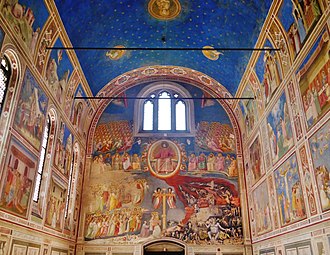
Yew Sunday (Domhnach an Iúir in Irish) is the medieval name for Palm Sunday – this is the day that Jesus entered Jerusalem in triumph on a donkey, with palm leaves being laid in front of him. It has always been very curious to me this so-short-lived triumph preceding such heavy and heart breaking tragedy. It is the Sunday before the Betrayal, which leads to the Crucifixion on Good Friday and the Resurrection on Sunday. A busy week for the Church.
Palm Sunday can be celebrated by making crosses out of palms, or with processions bearing palm branches or eating special cakes (there is always room in any ritual for cakes). But in the North where do you get your Palms from? So, it was often substituted by Box, or Olive or Willow and particularly, in Britain and Ireland, by Yew. Yew is evergreen and is so long lived as to be a symbol of everlasting life (I wrote more about the Yew here).
Giotto Bondone was a Florentine painter of the 14th Century of whom Giorgio Vasari, in his essential guide to the artists of the Renaissance, ‘The Lives of the Artists‘ said of the 10 year old:
One day Cimabue, going on business from Florence to Vespignano, found Giotto, while his sheep were feeding, drawing a sheep from nature upon a smooth and solid rock with a pointed stone, having never learnt from any one but nature. Cimabue, marvelling at him, stopped and asked him if he would go and be with him. And the boy answered that if his father were content he would gladly go. Then Cimabue asked Bondone for him, and he gave him up to him, and was content that he should take him to Florence.
There in a little time, by the aid of nature and the teaching of Cimabue, the boy not only equalled his master, but freed himself from the rude manner of the Greeks, and brought back to life the true art of painting, introducing the drawing from nature of living persons, which had not been practised for two hundred years; or at least if some had tried it, they had not succeeded very happily.
Written in 1550.
If you look at the painting, you will see, even more than his contemporary Duccio, the faces of the people are rounded and, and at least somewhat, individual. The crowd scene, particularly, to the right, has some depth and the people further away seem to recede from the viewer, rather than, as they often do in Byzantine style paintings, either float or seem to stand on or support themselves on each other’s shoulders. The Gate into Jerusalem has been rendered by someone who has seen something that he believes has the key to realistic scenes. One day it will be rediscovered, and named single-point perspective. Yes, Giotto doesn’t know the secret but he is working to find out what the trick is. The people in the trees are also in the distance. These are the giant strides that Vasari is referring to in the quotation above. Realistic people, in spaces with depth. The donkey is quite sweet too! Cimabue was particularly good at painting Crucifix scenes.
The Cappella degli Scrovegni in Padova is a World Heritage Site and Giotto and his team covered all the walls and ceiling with frescos, depicting the Life of Jesus, the Life of Mary, and the Last Judgement.

Here is a real Digital Heritage treat – a 360 Degree tour of the Chapel! Follow the link below. If it seems to be taking a long time to load there is an information button which, once pressed will allow the panorama to load immediately.
https://www.haltadefinizione.com/en/image-bank/giotto-di-bondone-scrovegni-chapel-360-view/
First Published in 2024, revised in 2025
Discover more from And Did Those Feet
Subscribe to get the latest posts sent to your email.

Giotto’s frescoes are a pure marvel!
So delicate… Stupendous colours…
Thanks for sharing them and for the very interesting comment on the Entry into Jerusalem.